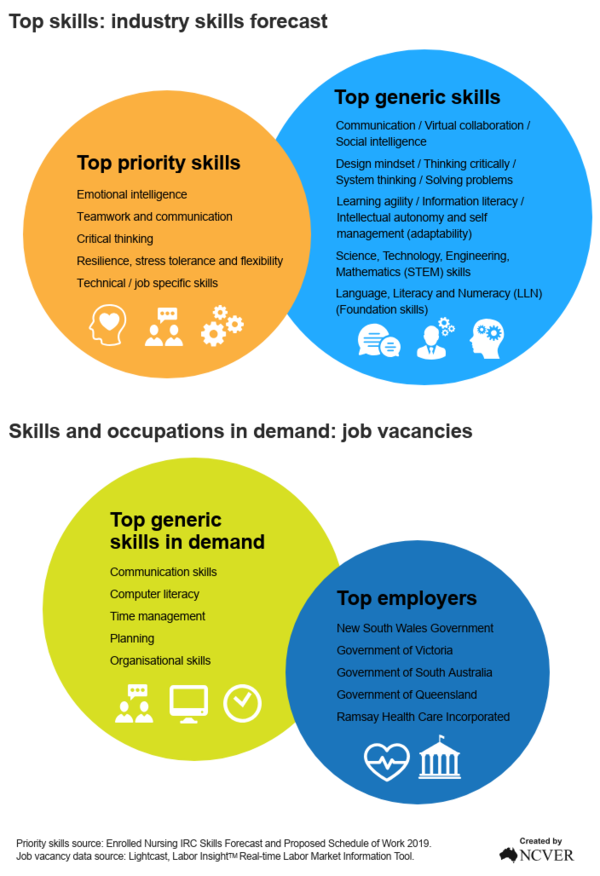
Industry insights on skills needs
The Enrolled Nursing IRC's 2019 Skills Forecast was the most recent industry skills forecast published by the IRC, as of September 2022. It identified the top priority skills for the sector as emotional intelligence, teamwork and communication, critical thinking, resilience, stress tolerance and flexibility and technical / job specific skills.
The top five identified generic skills were:
- Communication / Virtual collaboration / Social intelligence
- Design mindset / Thinking critically / System thinking / Solving problems
- Learning agility / Information literacy / Intellectual autonomy and self-management (adaptability)
- Science, Technology, Engineering, Mathematics (STEM) skills
- Language, Literacy and Numeracy (LLN) (Foundation skills).
According to the job vacancy data, the top requested skills by employers in the sector were communication skills and computer literacy. The top employers were the New South Wales Government and Government of Victoria.
According to the Enrolled Nursing IRC's 2019 Skills Forecast, both the health care environment in which Enrolled Nurses work and their clinical practices have evolved significantly in recent times. These changes have resulted in evolving skill and competence requirements for the Enrolled Nurse workforce. The sector overall has been experiencing several challenges which are impacting workforce skill requirements and, in summary, include:
- Skills shortages
- An ageing workforce
- Low retention of staff.
Skills shortages
A combination of factors continued to drive the evolution of the clinical practices required of Enrolled Nurses, and the environments they work in have changed significantly, thus shaping the evolution of Enrolled Nurses skill and competence requirements. These include changes to the Diploma of Nursing qualification, differing team environments, advancements in patient care and treatment, changing societal demographics, such as an ageing population, and treating and caring for vulnerable populations and people with chronic and acute conditions and comorbidities.
Technological innovation and development are also factors, with nurses increasingly using digital health technologies in the delivery of safe, quality and person-centred care. The National Nursing and Midwifery Digital Health Capability Framework, by the Australian Digital Health Agency outlined the core skills, knowledge and behaviours required for professional practice to guide contemporary practice that could be used by nurses and midwives, organisations and educators to help support professional development and training.
According to the Enrolled Nurses IRC 2019 Skills Forecast, the Australian health care system must keep pace with the impact of societal demands. To ensure these demands are met and to keep pace with the rapidly changing landscape, the Enrolled Nurses workforce requires ongoing skill development, particularly through the Health Training Package. The Enrolled Nurses IRC 2019 Skills Forecast, for example, identified that gerontology was an important skills and knowledge area in which the Enrolled Nurse workforce should be better equipped.
The Royal Commission into Aged Quality Care and Safety Final Report: Care, Dignity and Respect (Volume 3A: The New System) reported calls for the incorporation of gerontology care into the Enrolled Nurse Accreditation standards, which the Commonwealth Government supported in principle (see Royal Commission into Aged Care Quality and Safety: Submissions by the Commonwealth). However, it stated the curriculum delivered must be in accordance with the Health Training Package and this be considered as part of a review of Enrolled Nursing skills requirements.
Further, in response the industry concerns raised above and additionally, Skills IQ, under the direction of the Enrolled Nursing Industry Reference Committee, updated the Enrolled Nursing Training Package Products. The Australian Industry Skills Committee agreed to the proposed training package in early 2021.
Ageing workforce
According to the Enrolled Nurses IRC 2019 Skills Forecast, the sector’s employers are challenged to adapt or introduce workplace arrangements to retain a substantial number of mature-age workers. Three quarters (76%) of Enrolled Nurses were aged 35 years of age or over. The average age of an Enrolled Nurse was 46 years, which was significantly higher than the national job age average of 40 years. Job redesign, for example, were being considered as the sector sought to retain mature-age workers.
Retention of staff
The Enrolled Nursing IRC 2019 Skills Forecast reported the retention of high quality and skilled health care workforce was a challenge for industry, across all jurisdictions. It outlined some initiatives the Australian Government was implementing in an attempt to address the sustainability of the health care workforce, particularly nursing, including the Clinical Training Funding program, the Rural Health Professionals Program and the Expanded Scope of Practice Program.


